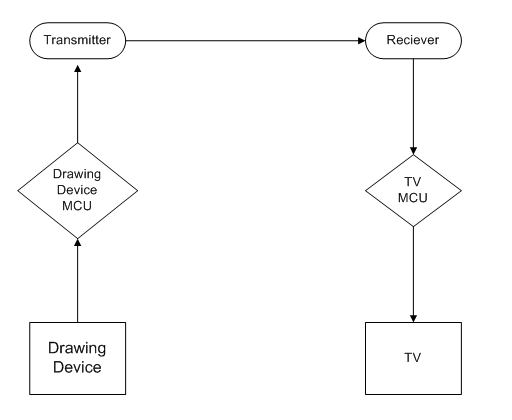 by David Tow
and Emily Cheng
by David Tow
and Emily Cheng by David Tow
and Emily Cheng
by David Tow
and Emily Cheng
Before we begin our design, there are some issues that we need to be be considered. There are two major parts to this wireless drawing device - a TV side and a keypad side. Therefore, there are two microcontrollers used: one for the TV side and one for the keypad side. The user interface (keypad side) of our drawing device consists of three buttons, left, right, and middle buttons, and a keypad or a mouse chassis. There is also a drawing pointer of size one pixel to ascertain where the drawing will occur on the TV.
There are three things that must be done in order to draw properly on the TV screen. The first is the drawing pointer movement. The pointer should be able to move up, down, left, right, and diagonally in all directions. The second thing is to draw on the TV screen. One needs to press the left button to draw wherever the drawing pointer is. Lastly, one needs to be able to erase the TV screen. One must press the right mouse button to erase wherever the mouse pointer is. If one presses the middle button, it will clear the TV screen and reset the drawing pointer to the center of the screen.
The connection is made via Universal Asynchronous Receiver and Transmitter (UART). We based our design on the Atmel Mega163 data sheet. On the keypad side, the microcontroller sends directional and button press signals to the transmitter via the TxD pin (PORTD.1), which is in turn received by the receiver on the TV side. These received signals go into the RxD pin (PORTD.0).
Also, the transmitter sends data at 433.92MHz. It
has a maximum data rate to 4800bits/sec. We calculate the baud rate by
using the formula given in the data sheet, UBR = fck/16(UBR+1), where
fck is the crystal clock frequency. This UBR equation can be
found in table 27 in the data sheet. For a 8MHz crystal, UBR = 103 will
give a baud rate of 4800.
In order to get optimal transmission
and reception, one needs to make the antenna approximately the size of
one-quarter the wavelength of the transmitted signals. In our case, the
wavelength is approximately 70 centimeters, and one-quarter of that is about 17
centimeters.
Our drawing device consists of three functions. The first
function is the movement the drawing device. For a keypad, one can press keys 1
through 9 for directions. Examples of these directions are 1 is move up
and left, and 6 is move right. On the TV screen, the drawing pointer will move
in the corresponding directions. The second function is to draw and erase
on the TV depending whether the left or right button is pressed. Lastly,
we need to encode the button presses and directional movements into a signal and
send the encoded signal to the television side via the transmitter-receiver
pair. On the TV side, we then need to decode the received signal in order to
show the graphic on the TV screen.
The basic hardware connection is
shown below:
